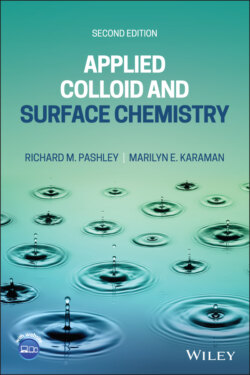Applied Colloid and Surface Chemistry

Реклама. ООО «ЛитРес», ИНН: 7719571260.
Оглавление
Richard M. Pashley. Applied Colloid and Surface Chemistry
Table of Contents
List of Tables
List of Illustrations
Guide
Pages
Applied Colloid and Surface Chemistry
Those that can, teach
Preface
About the Companion Website
1 Introduction
INTRODUCTION TO THE NATURE OF COLLOIDAL SOLUTIONS
THE FORCES INVOLVED IN COLLOIDAL STABILITY
TYPES OF COLLOIDAL SYSTEMS
THE LINK BETWEEN COLLOIDS AND SURFACES
WETTING PROPERTIES AND THEIR INDUSTRIAL IMPORTANCE
Appendix. A. DISPERSED PARTICLE SIZES
B. SOME HISTORICAL NOTES ON COLLOID AND SURFACE CHEMISTRY
2 Surface Tension and Wetting
THE EQUIVALENCE OF THE FORCE AND ENERGY DESCRIPTION OF SURFACE TENSION AND SURFACE ENERGY
DERIVATION OF THE LAPLACE PRESSURE EQUATION
METHODS FOR DETERMINING THE SURFACE TENSION OF LIQUIDS
CAPILLARY RISE AND A FREE ENERGY ANALYSIS
THE KELVIN EQUATION
THE SURFACE ENERGY AND COHESION OF SOLIDS
THE CONTACT ANGLE
Industrial Report. Photographic quality printing
SAMPLE PROBLEMS
Experiment Rod‐In‐Free‐Surface (Rifs) Method for the Measurement of the Surface Tension of Liquids. Introduction
Experimental procedures
FOR CONSIDERATION/TYPICAL QUESTIONS
Experiment Contact Angle Measurements. Introduction
Experimental procedures. Contact angle measurement
Sample preparation
Liquids used to determine the critical surface tension of methylated glass
FOR CONSIDERATION/TYPICAL QUESTIONS
3 The Prevention of Fluid Cavitation
A SHORT HISTORY OF CAVITATION IN FLUIDS
THEORETICAL PREDICTION OF THE LINK BETWEEN DEGASSING AND CAVITATION PRESSURE
Experimental study of the prevention of propeller cavitation in degassed water
Effects of degassed boundary‐layer films on a rotating propeller blade
Proposed new cavitation number to include the effects of fluid degassing
Industrial Report. Ship propeller cavitation
Experiment 3.1. Membrane degassing for water and aqueous solutions
Experimental evaluation of degassing in the prevention of cavitation
QUESTIONS
4 Thermodynamics of Adsorption
BASIC SURFACE THERMODYNAMICS
THE GIBBS ADSORPTION ISOTHERM
DETERMINATION OF SURFACTANT ADSORPTION DENSITIES
Industrial Report. Soil microstructure, permeability and interparticle forces
SAMPLE PROBLEMS
Experiment. Adsorption of Acetic Acid onto Activated Charcoal. Introduction
Experimental procedures
FOR CONSIDERATION/ TYPICAL QUESTIONS
5 Surfactants and Self‐Assembly
INTRODUCTION TO SURFACTANTS
THERMODYNAMICS OF SURFACTANT SELF‐ASSEMBLY
SELF‐ASSEMBLED SURFACTANT STRUCTURES
Surfactants and detergency
Industrial Report. Colloid science in detergency
SAMPLE PROBLEMS
Experiment. Determination of Micelle Ionization. Introduction
Experimental details
FOR CONSIDERATION/TYPICAL QUESTIONS
6 PFAS Contamination
BACKGROUND TO PFAS CONTAMINATION
SO HOW DO WE REMOVE PFAS COMPOUNDS FROM THE ENVIRONMENT?
A SURFACE CHEMISTRY APPROACH
Experiment 6.1 Co‐flotation removal of PFAS compounds from contaminated water. Introduction
Experimental details
QUESTIONS
7 Emulsions and Microemulsions
THE CONDITIONS REQUIRED TO FORM EMULSIONS AND MICROEMULSIONS
Emulsion or latex paints
PHOTOGRAPHIC EMULSIONS
EMULSIONS IN FOOD SCIENCE
EMULSIONS USED FOR EXPLOSIVES IN MINING OPERATIONS
Industrial Report
Experiment. Determination of the Phase Behaviour of Microemulsions. Introduction
Experimental procedures
FOR CONSIDERATION/TYPICAL QUESTIONS
Experiment. Determination of the Phase Behaviour of Concentrated Surfactant Solutions. Introduction
Experimental procedures
FOR CONSIDERATION/TYPICAL QUESTIONS
8 Charged Colloids
THE FORMATION OF CHARGED COLLOIDS IN WATER
THE DEBYE LENGTH
THE SURFACE CHARGE DENSITY
THE ZETA POTENTIAL
THE HUCKEL EQUATION (κa< 0.1)
THE SMOLUCHOWSKI EQUATION (κa> 100)
CORRECTIONS TO THE SMOLUCHOWSKI EQUATION
THE ZETA POTENTIAL AND FLOCCULATION
THE INTERACTION BETWEEN ELECTRICAL DOUBLE LAYERS
THE DERJAGUIN APPROXIMATION
Industrial Report. The use of emulsions in coatings
SAMPLE PROBLEMS
Experiment. Zeta Potential Measurements at the Silica/Water Interface. Introduction
Experimental procedures
Dark‐field illumination (zeta meter)
FOR CONSIDERATION/TYPICAL QUESTIONS
9 Van Der Waals Forces and Colloid Stability
HISTORICAL DEVELOPMENT OF VAN DER WAALS FORCES AND THE LENNARD‐JONES POTENTIAL
DISPERSION FORCES
RETARDED FORCES
VAN DER WAALS FORCES BETWEEN MACROSCOPIC BODIES
THEORY OF THE HAMAKER CONSTANT
USE OF HAMAKER CONSTANTS
THE DLVO THEORY OF COLLOID STABILITY
Some notes on van der Waals forces
Industrial Report. Surface chemistry in water treatment
SAMPLE PROBLEMS
NOTE
10 Bubble Coalescence, Foams and Thin Surfactant Films
THIN‐LIQUID‐FILM STABILITY AND THE EFFECTS OF SURFACTANTS
THIN‐FILM ELASTICITY
REPULSIVE FORCES IN THIN LIQUID FILMS
FROTH FLOTATION
THE LANGMUIR TROUGH
Laboratory Experiment Flotation of powdered silica. Introduction
Experimental procedures
Instructions
Contact angles
FOR CONSIDERATION/TYPICAL QUESTIONS
11 Bubble Column Evaporators
THE BUBBLE COLUMN EVAPORATOR PROCESS
BUBBLE WATER VAPOUR EQUILIBRATION
BUBBLE RISE VELOCITY
THERMAL ENERGY BALANCE IN THE BCE
FURTHER APPLICATIONS OF THE BUBBLE COLUMN EVAPORATOR (BCE)
BCE FOR EVAPORATIVE COOLING
SEAWATER DESALINATION USING THE BUBBLE COLUMN EVAPORATOR
ENHANCED SUPERSATURATED BUBBLE COLUMN DESALINATION
ENHANCED BUBBLE COLUMN DESALINATION USING HELIUM AS A CARRIER GAS
WATER STERILIZATION USING BCE
THERMOLYSIS OF SOLUTES IN AQUEOUS SOLUTION
INHIBITION OF PARTICLE GROWTH IN A BCE
SAMPLE QUESTIONS
Industrial Report. Bubble column evaporator
Experiment 11.1 Determination of the enthalpy of vaporization of concentrated salt solutions
Appendices. APPENDIX 1. FUNDAMENTAL CONSTANTS
IMPORTANT PROPERTIES OF WATER
USEFUL INFORMATION IN SURFACE CHEMISTRY
ZETA POTENTIALS
DEBYE LENGTHS
SURFACE CHARGE DENSITY
APPENDIX 2. MATHEMATICAL NOTES ON THE POISSON‐BOLTZMANN EQUATION
APPENDIX 3. NOTES ON 3‐D DIFFERENTIAL CALCULUS AND THE FUNDAMENTAL EQUATIONS OF ELECTROSTATICS
GAUSS’S LAW:
Index
WILEY END USER LICENSE AGREEMENT
Отрывок из книги
Second Edition
.....
This dramatic macroscopic difference in wetting behaviour is caused by only a thin molecular layer on the surface of glass and clearly demonstrates the importance of surface properties. The same type of effect occurs every day, when dirty fingers transfer natural grease and fats on to a drinking glass! Thorough cleaning of a glass flask (e.g., by washing in concentrated NaOH solution, as used in dishwashers) initially allows only a thin water film to coat (wet) the inside of the flask, producing visible coloured interference patterns (see photo). When contaminants from the air atmosphere slowly leak in via the stopper, this wetting film is displaced by a fine layer of non‐wetting droplets, forming an opaque mist film.
Figure 1.5 A non‐wetting water droplet on the surface of methylated, hydrophobic silica.
.....